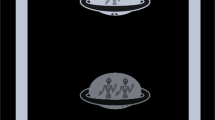Abstract
Objective
The purpose of this study was to evaluate the equivalence of smartphone-based measurements of near visual acuity under different screen brightness conditions with a standard near visual acuity test.
Methods
On a sample of 85 participants, we have evaluated near visual acuity with a smartphone-based version of the Radner reading chart at three distinct screen brightness levels. Results have been compared with those obtained with classical Radner paper charts.
Results
We have found that, when a sufficient screen brightness is employed, the smartphone-based version of the Radner reading chart produces results that are in line with the paper Radner charts while low brightness levels lead to a significant underestimation of reading acuities. This result was consistent across different refractive conditions.
Conclusions
In conclusion, we have shown that handheld devices, such as smartphones, can be potentially exploited for remote measurements of near visual acuity provided a correct control of brightness screen is employed.
This is a preview of subscription content, access via your institution
Access options
Subscribe to this journal
Receive 18 print issues and online access
$259.00 per year
only $14.39 per issue
Buy this article
- Purchase on Springer Link
- Instant access to full article PDF
Prices may be subject to local taxes which are calculated during checkout




Similar content being viewed by others
Data availability
The raw behavioral data have been deposited at Zenodo repository and are publicly available at the following address: https://doi.org/10.5281/zenodo.8158654.
References
Ritty JM, Solan HA, Cool SJ. Visual and sensory-motor functioning in the classroom: a preliminary report of ergonomic demands. J Am Optom Assoc. 1993;64:238–4.
Sheppard AL, Wolffsohn JS. Digital eye strain: Prevalence, measurement and amelioration. BMJ Open Ophthalmol. 2018;3:e000146.
Mehra D, Galor A. Digital screen use and dry eye: a review. Asia-Pac J Ophthalmol. 2020;9:491–7.
Nayak R, Sharma AK, Mishra SK, Bhattarai S, Sah NK, Sanyam SD. Smartphone induced eye strain in young and healthy individuals. J Kathmandu Med Coll. 2020;9:201–20.
Miranda AM, Nunes-Pereira EJ, Baskaran K, Macedo AF. Eye movements, convergence distance and pupil-size when reading from smartphone, computer, print and tablet. Scand J Optom Vis Sci 2018;11:1–5.
Bach M. The freiburg visual acuity test - automatic measurement of visual acuity. Optom Vis Sci 1996;73:49–53.
Bach M. The Freiburg Visual Acuity Test-Variability unchanged by post-hoc re-analysis. Graefe’s Arch Clin Exp Ophthalmol 2006;245:965–71.
Satgunam PN, Thakur M, Sachdeva V, Reddy S, Rani PK. Validation of visual acuity applications for teleophthalmology during COVID-19. Indian J Ophthalmol 2021;69:385–90.
Shin YD, Bae JH, Kwon EJ, Kim HT, Lee TS, Choi YJ. Assessment of pupillary light reflex using a smartphone application. Exp Ther Med 2016;12:720–4.
Cho P, Woo GC. Repeatability of the waterloo four-contrast LogMAR visual acuity chart and near vision test card on a group of normal young adults. Ophthalmic Physiol Opt 2004;24:427–35.
Tofigh S, Shortridge E, Elkeeb A, Godley BF. Effectiveness of a smartphone application for testing near visual acuity. Eye. 2015;29:1464–8.
Radner W, Willinger U, Obermayer W, Mudrich C, Velikay-Parel M, Eisenwort B. Eine neue Lesetafel* zur gleichzeitigen Bestimmung von Lesevisus und Lesegeschwindigkeit. Klin Monbl Augenheilkd 1998;213:174–81.
Calossi A, Boccardo L, Fossetti A, Radner W. Design of short Italian sentences to assess near vision performance. J Optom 2014;7:203–9.
Perera C, Chakrabarti R, Islam FMA, Crowston J. The Eye phone study: reliability and accuracy of assessing Snellen visual acuity using smartphone technology. Eye. 2015;29:888–94.
Rogulin A Brightness. 2018. Available at: https://play.google.com/store/apps/details?id=com.arogulin.brightness&hl=en_US&gl=US.
Pelli DG, Robson JG, Wilkins AJ. The design of a new letter chart for measuring contrast sensitivity. Clin Vis Sci 1988;2:187–99.
Radner W. Reading charts in ophthalmology. Graefe’s Arch Clin Exp Ophthalmol 2017;255:1465–82.
Cakmak HB, Cagil N, Simavli H, Duzen B, Simsek S. Refractive error may influence mesopic pupil size. Curr Eye Res 2010;35:130–6.
Linke SJ, Baviera J, Munzer G, Fricke OH, Richard G, Katz T. Mesopic pupil size in a refractive surgery population (13,959 eyes). Optom Vis Sci 2012;89:1156–64.
Shlaer S. The relation between visual acuity and illumination. J Gen Physiol 1937;21:255–81.
Green DG, Powers MK, Banks MS. Depth of focus, eye size and visual acuity. Vis Res. 1980;20:827–35.
Subramanian A, Pardhan S. The repeatability of MNREAD acuity charts and variability at different test distances. Optom Vis Sci 2006;83:572–6.
Xu R, Thibos L, Bradley A. Effect of target luminance on optimum pupil diameter for presbyopic eyes. Optom Vis Sci 2016;93:1409–19.
Boccardo L. Viewing distance of smartphones in presbyopic and non-presbyopic age. J Optom 2021;14:120–6.
Boccardo L, Gurioli M, Grasso PA. Viewing distance and character size in the use of smartphones across the lifespan. PLoS One. 2023;18:e0282947 https://journals.plos.org/plosone/article?id=10.1371/journal.pone.0282947.
Acknowledgements
We want to thank prof. Alessandro Farini for his helpful support in building up the stimuli used. We are grateful to Giulia Nesti and Letizia Lavezzi for their precious help in data collection.
Funding
The study was conducted with the contribution of the researcher Paolo Antonino Grasso with a research contract co-funded by the European Union - PON Research and Innovation 2014–2020 in accordance with Article 24, paragraph 3a, of Law No. 240 of December 30, 2010, as amended, and Ministerial Decree No. 1062 of August 10, 2021.
Author information
Authors and Affiliations
Contributions
PAG: Project Administration, Conceptualization, Methodology, Data Collection, Data Analysis, Writing; MG: Supervision, Review & Editing; LB: Supervision, Methodology, Writing, Review & Editing.
Corresponding author
Ethics declarations
Competing interests
The authors declare no competing interests.
Additional information
Publisher’s note Springer Nature remains neutral with regard to jurisdictional claims in published maps and institutional affiliations.
Rights and permissions
Springer Nature or its licensor (e.g. a society or other partner) holds exclusive rights to this article under a publishing agreement with the author(s) or other rightsholder(s); author self-archiving of the accepted manuscript version of this article is solely governed by the terms of such publishing agreement and applicable law.
About this article
Cite this article
Grasso, P.A., Gurioli, M. & Boccardo, L. Effects of brightness variations on a smartphone-based version of Radner reading charts. Eye (2024). https://doi.org/10.1038/s41433-024-02950-4
Received:
Revised:
Accepted:
Published:
DOI: https://doi.org/10.1038/s41433-024-02950-4



